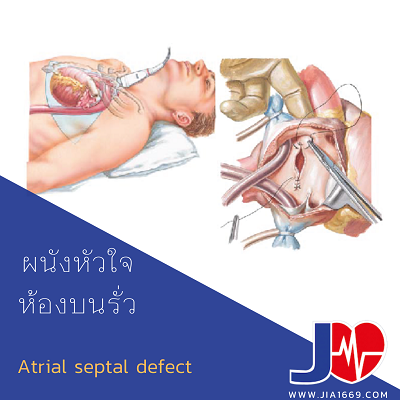ATRIAL SEPTAL DEFECT
Last updated: 6 Aug 2024 | 4771 Views |


![]()
ATRIAL SEPTAL DEFECT
The atria are the top chambers of the heart that send blood to the ventricles (bottom chambers). A septum is a wall separating the left and right sides of these chambers. An atrial septal defect (ASD) is an inborn (congenital) heart condition. It is a hole in the septum separating the left and right atria. The left side of the heart normally pumps under higher pressure than the right side. The defect produces a left-to-right shunt that allows blood from the two sides of the heart to mix. Blood with less oxygen is pumped to the body, and oxygenated blood travels back to the lungs. Abnormal circulation on the right
side of the system causes increased pressure in the lungs (pulmonary hypertension). ASD is more common in girls than boys. Some defects close as a child grows, but others may last into adulthood. ASD is the most common congenital heart defect diagnosed in adults. ASD
cannot be prevented
cause
The cause is unknown. ASD develops before birth and may last minto adulthood. ASD is more common in children with Down syndrome. The most common type of ASD, consisting of a
small opening, is called a patent (open) foramen ovale (PFO).
symptom
Small defects may not cause a problem. A large hole may produce weakness, breathing diffi culties, chest pain, bluish skin color, and abnormal heartbeats (arrhythmias). Larger defects eventually overload the system controlled by the right side of the heart, possibly causing heart failure (ineffi cient pumping).
diagnosis
The doctor may suspect the diagnosis on the basis of symptoms and fi ndings at physical examination (heart murmur). An electrocardiogram (ECG) may show abnormalities. A chest
x-ray may be abnormal, showing enlarged lung blood vessels and an enlarged heart. An echocardiogram (a test using ultrasound) can check the heart’s structure and pumping and
measure blood fl ow. The doctor may also recommend going to a cardiologist (a doctor who specializes in heart diseases) for more tests.
treatment
People with very small defects or defects that close may never have symptoms and need no treatment. People who need treatment may be referred to a cardiologist. Medicine may also
be given to treat symptoms. If the defect lasts, symptoms may develop that require treatment to correct the defect. Surgery is the preferred treatment and is usually done around the age of 4 years. If there is no other heart disease, correcting the defect usually allows a normal life span and lifestyle.
Things to do
![]() Do take medicines as prescribed by your doctor.
Do take medicines as prescribed by your doctor.![]() Do exercise, if your doctor says to do so.
Do exercise, if your doctor says to do so.![]() Do follow your doctor’s advice to make sure you have full
Do follow your doctor’s advice to make sure you have full
recovery and return to a normal life.![]() Do call your doctor if you have such symptoms as shortness
Do call your doctor if you have such symptoms as shortness
of breath, irregular heartbeat, chest pain, or bluish
discoloration of your fi ngers.
don't do
![]() DON’T ignore worsening symptoms. Get medical attention
DON’T ignore worsening symptoms. Get medical attention
immediately.
Related content
Percutaneous Coronary Intervention
23 Jun 2025
Atrial Myxoma
18 Aug 2022
Coronary Artery Bypass Surgery
23 Jun 2025
Tetralogy of Fallot
21 Sep 2022












